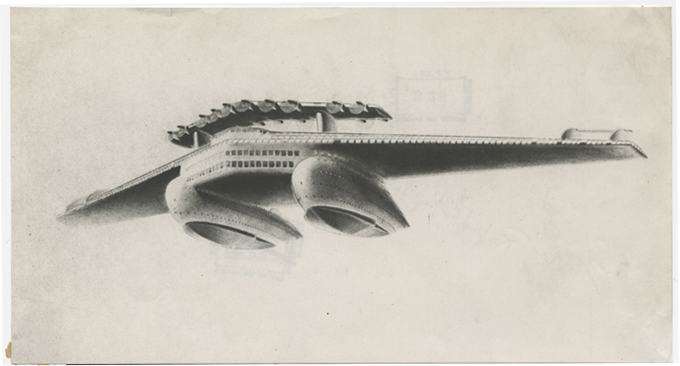
Image Credit: The Harry Ransom Center
Norman Bel Geddes, Airliner #4 rendering, ca. 1929-1932
Touring the Harry Ransom Center's Norman Bel Geddes exhibit a few weeks ago, my fellow viz. staffers and I were struck by how many of the designer's projects never made it past the drawing board. Bel Geddes' sketches of giant, amphibious aircrafts (see "Airliner #4" above) are prime examples of the far-fetched schemes his studio was hatching in the 30s alongside commercially viable designs, like this handsome pair of seltzer bottles featured in an earlier post. But, as other viz. contributers this week have remarked, articulating what is not and will never be seems like an inevitable part of a theorizing and designing the future. It certainly makes strolling through the Ransom Center's "I Have Seen the Future" exhibit feel like a trip into a delightful, hybrid world of fiction and history.
Geddes' plans for airborne commercial and recreational spaces (the 451 passengers aboard the flying machine, above, would have access to a gymnasium and a full orchestra) interest me because they present a counterpoint to the "auto-centric America" with which Geddes' work is usually associated. It's likely that Geddes' designs influenced both American aviation and automotive systems, but for an untrained industrial designer like Geddes, the first of these frontiers must have seemed significantly more difficult to modernize, if only from an engineering standpoint. The challenge of hoisting into the air a full spectrum of modern amenities makes Geddes' airplanes look almost cartoonish. Yet, when we recall that the horizon of space travel was not so far off, Geddes' airliners look less dream-like than before.
Recent comments
2 years 29 weeks ago
2 years 44 weeks ago
2 years 44 weeks ago
2 years 50 weeks ago
3 years 4 weeks ago
3 years 4 weeks ago
3 years 4 weeks ago
3 years 6 weeks ago
3 years 6 weeks ago
3 years 6 weeks ago